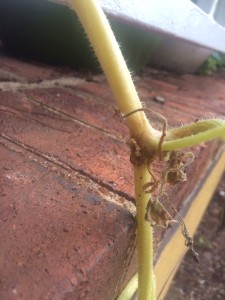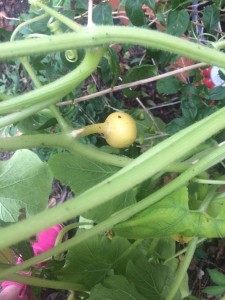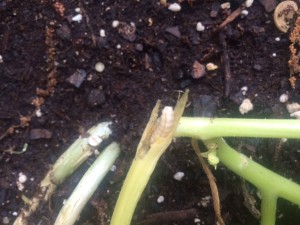I’m not happy at all about this post. After a summer that I’ve been pretty proud of, I lost two squash plants to vine borers.
In case you don’t know what squash vine borers are, here’s the deal. There’s a little moth that likes to lay its eggs on squash leaves. When those eggs hatch, the larvae bore their way into the middle of the hollow stem. They eat their way through your plant, killing it as they grow stronger. Little bastards. After the larvae stage, they drop into the soil and live over the winter as pupae. And then those little buggers hatch in the spring to start the whole cycle again.
What’s particularly terrible about vine borers is how quickly they kill your plant. Both my Red Kiri and Marina di Chioggia winter squashes were lush and healthy Wednesday night and almost completely dead Thursday morning. So I’m not happy to say that they got me again.
Here are some pictures so you’ll know what to look for with your squash:
First, when the dreaded larvae bore into the vine, they leave behind frass. This is the chewed-up stuff you can see in this picture. Right where the vine splits.
Here’s a cute little squash that didn’t quite make it. I never knew ye’, Marina di Chioggia squash!
And here’s what the larvae looks like when you cut open the vine.
Have I mentioned that I hate these things?
So what can you do about vine borers?
- Plant resistant plants. Vine borers like the types of cucurbits with hollow stems, so the solid-stemmed plants are safe. Like cucumbers. Or pumpkin.
- Some people swear by wrapping the stem of their plants with something that prevents the larvae from getting to it. I’ve heard of both pantyhose and aluminum foil. Having never tried this, I can’t help you!
- Sevin dust. This definitely works but I don’t use it. I wouldn’t want to risk hurting my bees.
- Aluminum foil mulch. I meant to try this this year but I got so distracted by other gardening tasks that I’ve been pretty neglectful of the vegetables. Basically, you cover the entire surface of the dirt with aluminum foil, thus preventing hatched moths from getting out of the soil.
- Beneficial nematodes. I think these are the reason I’ve had so little loss this year. You mix them into your soil and they kill the pupae. I just missed these two planters because they weren’t on the porch with the others.
- Plant surgery! This part is fun, but I’ve not been terribly successful with it. But hey, once vine borers are there the plant is going to die anyway, so it’s worth a try. Anyway, you cut out the larvae and then bury the part of the stem that you cut. With luck, this will take root and you can save your plant.



